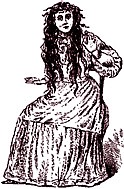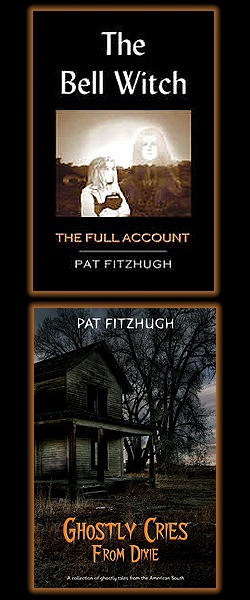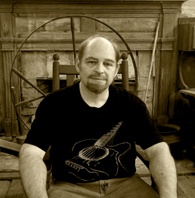The Ingram Book is Scrutinized
One of the more popular “Bell Witch theories” to emerge over the past decade centers on the first book written about the case, which was published by newspaper editor Martin Ingram of Clarksville, Tennessee, in 1894. Being the author of the first book that was published about something is an honorable distinction, but it also can be a curse.
A “first book” is often the starting point for people researching a case such as the Bell Witch, and as such, validating the original author’s claims is paramount to the research. But, what if the author is deceased, as is the case with Ingram? What the author's primary sources were destroyed, or went missing, as is the case with Ingram? It comes as no surprise that the first published accounts of allegedly true events, in a paranormal context, often fall victim to harsh, repetitive scrutiny. And, that is well and fine if it filters out the fluff and helps the researcher get to the bottom of the case.
Because Martin Ingram is long deceased--he died in 1909--and his alleged source document, Richard Bell's "Our Family Trouble" manuscript, has yet to be found, "An Authenticated History of the Bell Witch" is often scrutinized. Some feel he made up the legend. Did he? Or, did he take an existing tale and embellish it to epic proportions? Or, is the whole thing true? Welcome to the jungle.
The Ingram Fabrication Theory Defined
The skeptical “Ingram Fabrication Theory” suggests that there was no Bell Witch prior to 1894, except, perhaps, hidden away somewhere in the back of Ingram’s mind. The main premise behind the theory is summed up, as follows:
“If the alleged disturbances were so frightening and extraordinary that people came from all over the country to witness them, as Ingram stated, people would have written volumes about the disturbances. Yet, the earliest published account came almost 75 years later, from Ingram, in 1894. Since nothing was published about the Bell Witch prior to Ingram’s book, except a short blurb in an 1886 history book that he allegedly penned, he must have made the story up.”
Serious researchers of the legend have not accepted such a convenient, generalized conclusion as fact, namely because the theory’s proponents have failed to prove that was the case. It needs to be remembered that the burden of proof is carried by the person(s) making a claim, whether it be a paranormal claim or a claim that something is not real. In other words, if you said it, you own it. Rather than own (prove) their claim of fabrication, proponents have chosen to present a “compelling circumstance” that adds a false sense of validity to their argument.
The compelling circumstance—that Ingram’s alleged source document, "Our Family Trouble," was never found—sounds compelling, but lacks persuasion. The manuscript could turn up any day or week now, ten years from now, one-hundred years from now, or not at all. Perhaps Ingram wrote the manuscript himself? None of that is relevant to this discussion. The proverbial bottom line is that neither its existence nor its non-existence has been proven.
Would the existence or non-existence of Ingram’s source document be discussion-worthy if the Fabrication Theory’s main premise—that nothing was published about the Bell Witch until Ingram’s 1894 book—is proven false? No. Although the unknown origin of Ingram's source document suggests possible embellishment on his part, it falls short of proving that he made up the entire legend, as the theory states.
Searching for the Holy Grail
A pre-1894 account of the Bell Witch—which some Fabrication theorists have said would amount to the “HOLY GRAIL”—would not, in and of itself, solve the Bell Witch mystery (who, or what, was the Bell Witch?), nor would it rule out embellishment on Ingram’s part. It would simply invalidate the theory that Ingram fabricated the legend. Given the attention the theory has received over the last twenty years, finding a pre-1894 published "holy grail" Bell Witch account would amount to a significant advance in the case.
Enter the Holy Grail
Two earlier published accounts have come to light in recent years. They are the Green-Mountain Freeman / Saturday Evening Post account and the Journal of Captain John R. Bell (no relation to the Bell family of Red River).
The Green-Mountain Freeman / Saturday Evening Post Account
Several accounts, including Ingram’s, tell of an ~1849 article that appeared in The Saturday Evening Post, blaming the entire ordeal on Betsy Bell, and how it was later retracted when Betsy Bell Powell threatened to file a defamation suit against The Post if they did not publish a retraction. Although finding the article would prove that the story existed before Ingram’s book was published, researchers been unable to find an archived copy of the article; its existence, absent any physical evidence, has amounted to hearsay from Ingram.
It comes as no surprise that Ingram Fabrication theorists readily dismiss the elusive Post article as a fictitious device used by Ingram to add credibility to his story.
I searched for the 1849 Saturday Evening Post article at the Library of Congress in Washington D.C. about 20 years ago, but only found a later, 1850s-period article (listed in an index-only document that showed only the title) that some well-intentioned librarian had categorized as a “Tennessee Ghoulish Haunt.” With so little to go on--the wrong period, no cross-references with additional information, and no direct mention of the Bell Witch in the category's description--I decided to just make a note of it and “let it go,” with no further time spent researching it. So close, but yet so far; it was a painful dead end, but not the end.
In November of 2016, I was advised that new information about the 1849 Saturday Evening Post article had recently come to light. An early REPRINT of the Post article had surfaced, and it was dated many years prior to 1894. Although an archived copy of the original article as it appeared in the Post continues to elude researchers, the reprint's early publication date, along with its direct reference to the Saturday Evening Post's article, sufficiently proves that Ingram did not make up the Bell Witch legend, nor did he lie about there having been an article about it in the Post. Welcome to the holy grail.
On February 7, 1856, the Green-Mountain Freeman, a newspaper based in Montpelier, Vermont, reprinted the Post article, entitled “The Tennessee Ghost.” It was featured on the Freeman's front page, in the Variety section, which contained article reprints from newspapers around the country. There can be no mistake as to the reprint’s original source; the Freeman's editor attributed it directly to The Saturday Evening Post.
The reprinted Saturday Evening Post article, which briefly describes the disturbances and the many curiosity-seekers who visited the Bell farm, mentions John Bell, Betsy Bell, Joshua Gardner, and Robertson County, Tennessee. It directly accuses Betsy Bell of using ventriloquism to stage the entire haunting. Her motive, it says, was to ensure that she would marry Joshua Gardner, a young man with whom she had fallen in love. When asked when it would leave, the Bell Witch entity would reply, “not until Joshua Gardner and Betsy Bell get married.” This version of the legend is much different from Ingram’s, which states that the entity was strongly opposed to Joshua Gardner and Betsy Bell marrying.
The Bell Witch legend had already been published and was widely known—at least as far away as the New England states—some 45 years before Ingram published his book (38 years if you count from the Freeman reprint date).
The Bell Witch Site
Recommended Books
The Bell Witch SiteOn Social Media The
Bell Witch Site | Copyright © 1995
- 2025 Pat Fitzhugh On Social Media
Pat Fitzhugh's Official Web Site
|
The Ingram Bell Witch Fabrication Theory Debunked
"Ingram was not the first to write about the Bell Witch"
Preface
In recent years, some have come to believe that Martin Ingram "made up" the entire Bell Witch legend, because no written mention of the legend occurred prior to his 1894 book. A tiny blurb about the legend appeared in an 1886 vanity history book (Goodspeed's History of Tennessee - Robertson County), but proponents of the fabrication attribute it to Ingram as well. However, information that has recently come to light disproves the theory's major premise. As it turns out, the Bell Witch legend was around long before Ingram penned his account.
-- Pat Fitzhugh, January 2017
View the front page and Bell Witch article online at the Library of Congress: Green-Mountain Freeman - February 3, 1856
The Journal of Captain John R. Bell
This development, like the Green-Mountain Freeman article, is not a newly-discovered secret, or missing piece of a puzzle. It was written in 1820, held by the writer’s family until the 1930s, and published to a scholarly audience in the 1950s. I call it a “new development” because its reference to the Bell Witch, although not by name, but through historical context, was found in modern times. I was not the person who found it, but I have been hearing about it for some time. Recently, I was provided with a link to the actual document for analysis and comment.
The new development is an entry made in a journal kept by Army Captain John R. Bell (no relation to the “Bell Witch” Bells) while working as the official journalist for Stephen H. Long’s expedition to the Rocky Mountains in 1820. The journal covers from March 13th to November 20th of that year. In addition to writings about the famed expedition, the journal also contains entries from Captain Bell’s return trip from Cape Girardeau, Missouri, to Washington, D.C. It was during that last leg of his journey when, on October 19, 1820, he passed through the Red River area of northwestern Middle Tennessee.
While spending the day at a plantation, he was told about a young girl surrounded by voices that relentlessly urged her to marry a neighbor. Although Captain Bell did not call the John Bell family by name, the year and location, along with the girl living three miles away, leaves no doubt that Betsy Bell was the centerpiece of the story related to Captain Bell. Also, an account published some 30-35 years later told the same story and mentioned Betsy Bell by name. In his journal, Captain John R. Bell wrote:“Rather a single circumstance was here related to me. of a young girl of about 15 years of age, residing but 3 miles from Murphey, a voice accompanies her, which says she should marry a man, a neighbor–thousands of persons have visited her to hear this voice, in many instances, it will reply to questions put to it, the visitors have left as little satisfied in their curiosity as before they heard it, many are under the impression, that it is ventriloquism imposed upon the hearers either by the girl or her brother–who it seems is generally in her company, her family is respectable.”
A Researcher’s Analysis of Captain John R. Bell's Account
Captain Bell’s use of the phrase, “related to me,” in the introductory sentence, indicates that his account is second-hand (hearsay), meaning he was not an eyewitness. Hearsay accounts indeed make the mystery bigger, and perhaps more entertaining from a storytelling perspective, but they neither solve the mystery nor add substance to the investigation. Every account of the Bell Witch in book, article, documentary, and movie form that discusses the alleged events of 1817-1821 has been second-hand. Every Single One.
I am well-aware of “Our Family Trouble,” the alleged eyewitness account of Richard Williams Bell that is contained in, and serves as the cornerstone of, Martin Ingram’s 1894 work of fiction. No one has come forward with the actual document (although many have claimed to have it), and a skeptical analysis of the writing style, references to scripture, use of cliche’ words, and Freemasonry references, conducted in 2015, suggests that Ingram was likely the author of the “eyewitness” account. For those reasons, and reasons of my own, I do not consider the “Our Family Trouble” eyewitness manuscript as valid, primary evidence in the Bell Witch case (and why should I? I have yet to see or examine it. But, if you have it, bring it to me and let me have it analyzed–and prove me wrong).
Is there an old, first-person eyewitness account of the Bell Witch stuffed away in a rotting trunk in someone’s attic, or basement, that tells the “real truth” of the Bell Witch mystery? Many have claimed to possess such documents, and some have used their supposed existence as the basis for books and movies, perhaps to create an illusion of credibility. The bottom line is that those claiming to have these “holy grail” documents seemingly vanish into thin air when serious researchers ask to examine the documents and have the paper and handwriting professionally analyzed for authenticity. That is a simple, reasonable request under the circumstances; extraordinary claims require extraordinary proof.
If most anyone had such an important, game-changing document, they would be eager to have it professionally analyzed so as to garner support among researchers. No theory, Bell Witch or otherwise, will advance very far, much less see the light of day, without acceptance and support from the research community. At the end of the day, they are the people most listened-to, and the ones who will ultimately champion and promote your theory to the masses.
Captain Bell's Second-Hand Account Adds Much Value to Research
Thankfully, Captain John R. Bell’s journal is accessible. And, given its clear, spelled-out chain of transmittal through the years, there is no reason to doubt its authenticity. Why is this second-hand account so important? Does it add any value? You betcha.
While Captain Bell’s second-hand (hearsay) account does not solve the mystery of the Bell Witch, or propel the investigation along in a more fruitful way, it is significant to Bell Witch researchers because it was written in 1820, 12 years before Martin Ingram was born, and serves to further debunks the Ingram Fabrication Theory. There was no way Ingram could have written or influenced the entry in Captain Bell's journal.
It is also noteworthy that Captain Bell’s account is, essentially, the same story–a young girl surrounded by voices saying to marry Joshua Gardner–that was published by the Saturday Evening Post 30 to 35 years later, and reprinted by the Green-Mountain Freeman in Vermont on February 7, 1856. Captain Bell’s journal did not mention the Bell family by name, but the Saturday Evening Post article did, which suggests that the two early accounts, written 30 to 35 years apart, relate the same story but came from different sources.
I will also note that the two early accounts make no mention of Betsy going into trances, having her hair pulled, being beaten, or suffering any other misfortunes except, perhaps, not getting to marry the love of her life. Those two earliest accounts also make no mention of an invisible entity predicting the future, speaking in preachers’ own voices, gnawing on bedposts, or turning farm workers into giant rabbits and mules and “riding them to hell for breakfast.”
To summarize, Captain Bell’s journal, because it was written before Ingram was born, fully debunks the Ingram Fabrication Theory. And, when viewed along with the Green-Mountain Freeman reprint from The Saturday Evening Post, shows that the Bell disturbances–how ever benign or severe they might have been–had indeed become known to people outside of the Middle Tennessee region.
Click here to read Captain John R. Bell's full journal.-- Pat Fitzhugh



